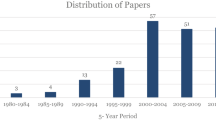Abstract
The study of group dynamics highlights the activity in the group in terms of its performance and communication. The experience of facilitating virtual communities and teams (Eunice and Kimball in http://www.Tmn.com/~lisa/odn-teams.htm, 1997) suggests that groups go through the same stages either in face-to-face or in online mode. The paper brings together a theoretical framework based on the literature on virtual communities, Gestalt systems and online facilitation in order to address the issue of electronic togetherness, in particular from a group dynamics perspective. The empirical work on which the paper is based is an observation of a group of students in a training set playing a decision-making game. The model of Tuckman (Tuckman in Psychol Bull 63:384–399, 1965; Tuckman and Jensen in Group Organ Stud 2:419–427, 1977) is used as a framework within which to discuss the findings of the case. The paper finishes with concrete recommendations for facilitators of online communities and designers of the electronic spaces where these communities operate.
Similar content being viewed by others
Explore related subjects
Discover the latest articles, news and stories from top researchers in related subjects.References
Albuquerque AL, Velho L (2003) Togetherness through virtual worlds: how real can be that presence? http://www.visgraf.impa.br/RefBib/Data/PS_PDF/nelmapresence2002/togetherness2002.pdf
Armstrong D (1999) Making absences present: the contribution of WR Bion to understanding unconscious social phenomena. http://www.shef.ac.uk/~psysc/group/chap3.html
Arnheim R (1999) Gestalten and computers. Gestalt Theory J 21(3):181–183
Benne S, Sheats B (1948) Functional roles of group members. J Soc Issues 4:41–49
Bentley T (1994) Facilitation: providing opportunities for learning. J Ind Train 18(5):8–22
Chia R (1999) A rhizomic model of organisational change and transformation: perspective from a metaphysics of change. Br J Manag 10:209–227
Clarkson P (1995) Change in organisations. Whurr Publications, London
Dey I (1999) Grounding grounded theory. Academic, New York
Deleuze G, Guattari F (1972) Anti-oedipus, capitalism and schizophrenia, translated by Huxley R, Seem M, Lane H. Viking Press, New York
Durlach N, Slater M (1998) Presence in shared virtual environments and virtual togetherness. BT presence workshop. http://www.cs.ucl.ac.uk/staff/m.slater/BTWorkshop/durlach.html
Estes CP (1992) Women who run with the wolves. Rider Publications, UK
Eunice A, Kimball L (1997) Zen and the art of facilitating virtual teams, presentation for OD network annual conferment, October 1997. http://www.Tmn.com/~lisa/odn-teams.htm
Fernback J, Thompson B (1995) Computer mediated communication and the American collectivity: the dimension of community within cyberspace. In: Annual convention of the international communication association, Albuquerque, NM
Grudin J (1994) Groupware and social dynamics: eight challenges for developers. Commun ACM 37(1):92–105
Hildreth P, Kimble C, Wright P (1998) Computer mediated communications and international communities of practice. In: Proceedings of Ethicomp’98, March. Erasmus University, The Netherlands, pp 275–286
Honey P (1994) Teams and leaders, Trainer’s guide. Melrose Film Productions
Hunt J (1979) Managing people at work. Pan
Jarvenpaa SL, Leidner DE (1998) Communication and trust in global virtual teams. J Comput Mediat Commun 3(4)
Jones Q (1997) Virtual communities, virtual settlements and cyber-archaeology: a theoretical outline. J Comput Mediat Commun 3(3). http://www.ascusc.org/jcmc/vol3/issue3/jones.html
Jorn L, Duin AH, Wahlstrom (1996) Designing and managing virtual learning communities. IEEE Trans Prof Commun 39(4):183–191
Lave J, Wenger E (1991) Situated learning. Cambridge University Press, Cambridge
Levin JA (1992) Education on the networks of today and tomorrow: the integration of computer-supported cooperative learning and work. ACM SIGCUE Outlook 21(3):8–9
Nicolopoulou K (2001) Internal report on on-line facilitation competences
Nicolopoulou K, Kostomaj M (2002) Evaluation of the group dynamics in the decision-making game. Internal report
Norman DA (2002) The design of everyday things. Basic Books, New York, reprint 1988 (originally published as The psychology of everyday things)
Palloff R, Pratt K (1999) Defining and redefining community, chapter 2. In: Building learning communities in cyberspace: effective strategies for the online classroom. Jossey-Bass, San Francisco
Pinelle D, Gutwin C (2001) Group task analysis for groupware usability evaluations. In: Proceedings of IEEE wetice 2001
Poldony JM, Page KL (1998) Network forms of organisation. Annu Rev Sociol 24:57–76
Preece J (2000) Online communities: designing usability, supporting sociability. Wiley, Chichester
Rees F (1998) The facilitator excellence handbook: helping people work creatively and productively together. Jossey-Bass/Pfeiffer, San Francisco
Reynolds M (1994) Groupwork in education and training. Kogan Page, London
Rheingold H (1993) The virtual community: homesteading on the electronic frontier. Addison-Wesley, New York
Sinclair G, Cuttell D, Vandeveer R, Menefee M (2002) Human behavior in organizations, 4th edn. Pearson Custom Publishing, Boston
Spiegelberg S (1982) The phenomenological movement: a historical introduction, 3rd edn. M. Nijhof Publishers, Hague
Swan M, Walter C (1997) How English works. OUP, Oxford
Tapscott D, Gaston A (1993) Paradigm shift: the new promise of information technology. McGraw-Hill, New York
Tolmie A, Boyle J (2000) Factors influencing the success of computer mediated communication (CMC) environments in university teaching: a review and case study. Comput Educ 34(2):119–140
Tuckman B (1965) Developmental sequence in small groups. Psychol Bull 63:384–399
Tuckman B, Jensen M (1977) Stages of small group development. Group Organ Stud 2:419–427
Walls J (1993) Global networking for local development. In: Harasim L (ed) Global networks. MIT Press, Cambridge
Wenger EC, Snyder WM (2000) Communities of practice: the organizational frontier. Harv Bus Rev, January
Wertheimer (1924) Source book of Gestalt psychology, translated by Ellis W, 1938. Harcourt, Brace and Co., New York
White N (2001) The arts of facilitation. http://www.fullcirc.com/community/communityfacilitation.htm
Yin RK (1994) Case study research, design and methods. Sage publications, Beverly Hills
Author information
Authors and Affiliations
Corresponding author
Rights and permissions
About this article
Cite this article
Nicolopoulou, K., Koštomaj, M. & Campos, A. How to address group dynamics in virtual worlds. AI & Soc 20, 351–371 (2006). https://doi.org/10.1007/s00146-005-0027-0
Received:
Revised:
Published:
Issue Date:
DOI: https://doi.org/10.1007/s00146-005-0027-0




